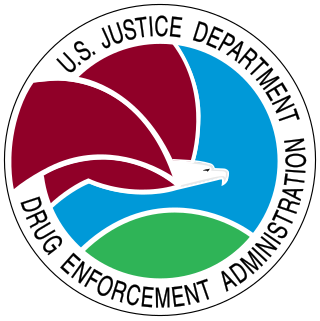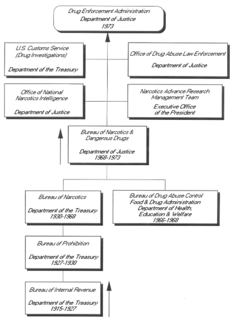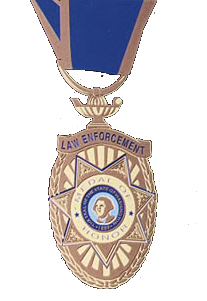
The Purple Heart (PH) is a United States military decoration awarded in the name of the President to those wounded or killed while serving, on or after April 5, 1917, with the U.S. military. With its forerunner, the Badge of Military Merit, which took the form of a heart made of purple cloth, the Purple Heart is the oldest military award still given to U.S. military members – the only earlier award being the obsolete Fidelity Medallion. The National Purple Heart Hall of Honor is located in New Windsor, New York.

The Drug Enforcement Administration is a United States federal law enforcement agency under the U.S. Department of Justice tasked with combating drug trafficking and distribution within the U.S. It is the lead agency for domestic enforcement of the Controlled Substances Act, sharing concurrent jurisdiction with the Federal Bureau of Investigation, the U.S. Immigration and Customs Enforcement's Homeland Security Investigations, U.S. Customs and Border Protection and the Department of Homeland Security. The DEA has sole responsibility for coordinating and pursuing U.S. drug investigations both domestic and abroad.
A special agent is an investigator or detective for a governmental or independent agency, who primarily serves in criminal investigatory positions. Additionally, many federal and state "special agents" operate in "criminal intelligence" based roles as well. Within the U.S. federal law enforcement system, dozens of federal agencies employ federal law enforcement officers, each with different criteria pertaining to the use of the titles Special Agent and Agent.

A police dog is a dog that is specifically trained to assist police and other law-enforcement personnel. Their duties include: searching for drugs and explosives, locating missing people, finding crime scene evidence, and attacking people targeted by the police. Police dogs must remember several verbal cues and hand gestures. The most commonly used breeds are the German Shepherd, Belgian Malinois, Bloodhound, Dutch Shepherd, and the retriever breeds. Recently, the Belgian Malinois has become the dog of choice for police and military work due to their intense drive and focus. Malinois are smaller and more agile than German Shepherd Dogs, and have fewer health issues. However, a well-bred working line German Shepherd Dog is just as successful and robust as a Malinois.
Clandestine chemistry is chemistry carried out in secret, and particularly in illegal drug laboratories. Larger labs are usually run by gangs or organized crime intending to produce for distribution on the black market. Smaller labs can be run by individual chemists working clandestinely in order to synthesize smaller amounts of controlled substances or simply out of a hobbyist interest in chemistry, often because of the difficulty in ascertaining the purity of other, illegally synthesized drugs obtained on the black market. The term clandestine lab is generally used in any situation involving the production of illicit compounds, regardless of whether the facilities being used qualify as a true laboratory.

Thomas A. Constantine served as Administrator for the Drug Enforcement Administration (DEA) between March 1994 and July 1999.

The Bureau of Narcotics and Dangerous Drugs (BNDD) was a bureau within the United States Department of Justice (DOJ) and a predecessor agency of the modern Drug Enforcement Administration (DEA).

United States law enforcement decorations are awarded by the police forces of the United States of America. Since the United States has a decentralized police force, with separate independent departments existing on the state and local level, there are literally thousands of law enforcement decorations in existence.
The Federal Bureau of Narcotics (FBN) was an agency of the United States Department of the Treasury. Established in the Department of the Treasury by an act of June 14, 1930, consolidating the functions of the Federal Narcotics Control Board and the Narcotic Division. These older bureaus were established to assume enforcement responsibilities assigned to the Harrison Narcotics Tax Act, 1914 and the Narcotic Drugs Import and Export Act, 1922.
Grayston L. Lynch was an American soldier and CIA officer. He was one of the two CIA officers who commanded the faction of the army that went to war in the Bay of Pigs Invasion. The other agent was William "Rip" Robertson.
The Narcotics Rewards Program is a program of the United States Department of State that offers rewards up to US$5 million for information leading to the arrest or conviction of major international narcotics traffickers who send drugs into the United States. It was established by Congress in 1986, and as of 2011 it has paid out over $62 million.

Created in 1983, the Campaign Against Marijuana Planting (CAMP) is a multi-agency law enforcement task force managed by the California Department of Justice and composed of local, state and federal agencies organized expressly to eradicate illegal cannabis cultivation and trafficking in California. With more than 110 agencies having participated, CAMP was the largest law enforcement task force in the United States.

A Law Enforcement Purple Heart is a generic term to describe an American law enforcement medal which may be issued to any law enforcement officer who is injured, wounded or killed in the line of duty. The term is based on the Purple Heart Medal issued by the United States Armed Forces. One of the major pushing organizations for the Purple Heart for Law Enforcement is the National Associations of Chiefs of Police who award the Law Enforcement Purple Heart.
The federal government of the United States empowers a wide range of law enforcement agencies to maintain law and public order related to matters affecting the country as a whole.

The Suffolk County Sheriff's Office is the oldest law enforcement agency in Suffolk County, New York, having been established in 1683. The Sheriff's Office currently employs over 1200 people, including 898 correction officers, 288 deputy sheriffs, and 130 civilian personnel. Its Office and Business Operations are located at the Riverhead Correctional Facility, 100 Center Drive South in Riverhead.

The illegal drug trade in Latin America concerns primarily the production and sale of cocaine and cannabis, including the export of these banned substances to the United States and Europe. The Coca cultivation is concentrated in the Andes of South America, particularly in Colombia, Peru and Bolivia; this is the world's only source region for coca.
United States v. Mendenhall, 446 U.S. 544 (1980), was a United States Supreme Court case that determined "seizure" occurs when an officer uses displays of authority to detain a person.

Enrique "Kiki" Camarena Salazar was an American intelligence officer for the United States Drug Enforcement Administration (DEA). In February 1985 Camarena was kidnapped by drug traffickers in Guadalajara, Mexico. He was interrogated under torture and murdered. Three leaders of the Guadalajara drug cartel were eventually convicted in Mexico for Camarena's murder. The U.S. investigation into Camarena's murder led to three more trials in Los Angeles for other Mexican nationals involved in the crime. The case continues to trouble U.S.-Mexican relations, most recently when one of the three convicted traffickers, Rafael Caro Quintero, was released from Mexican prison in 2013.
Operation Anvil was a ninety-day pilot program conducted by the members of United States Drug Enforcement Administration (DEA)’s Foreign-deployed Advisory and Support Team (FAST) and officers from the Honduran National Police's Tactical Response Team (TRT) against drug trafficking from South America to Honduras." which began in April 2012. During the operation in 2012 there were "three deadly force incidents, on May 11, 2012, June 23 and July 3. On May 11 DEA agents and Honduran police "killed and injured innocent civilians during the operation and ... abused residents in a nearby village." News of the incident was widely publicized. This led to a joint review by the U.S. Department of State (DOS), the U.S. Office of the Inspector General (OIG) and the U.S. Department of Justice (DOJ) of drug interdiction missions. Their 424-page report on Operation Anvil was published in May 2017.

The Washington Law Enforcement Medal of Honor is the only state decoration issued by the state of Washington to law enforcement officers, and is established by the Revised Code of Washington.. Washington law does not describe an order of precedence for state decorations and the Washington Law Enforcement Medal of Honor is not customarily placed in relation to other state decorations.











